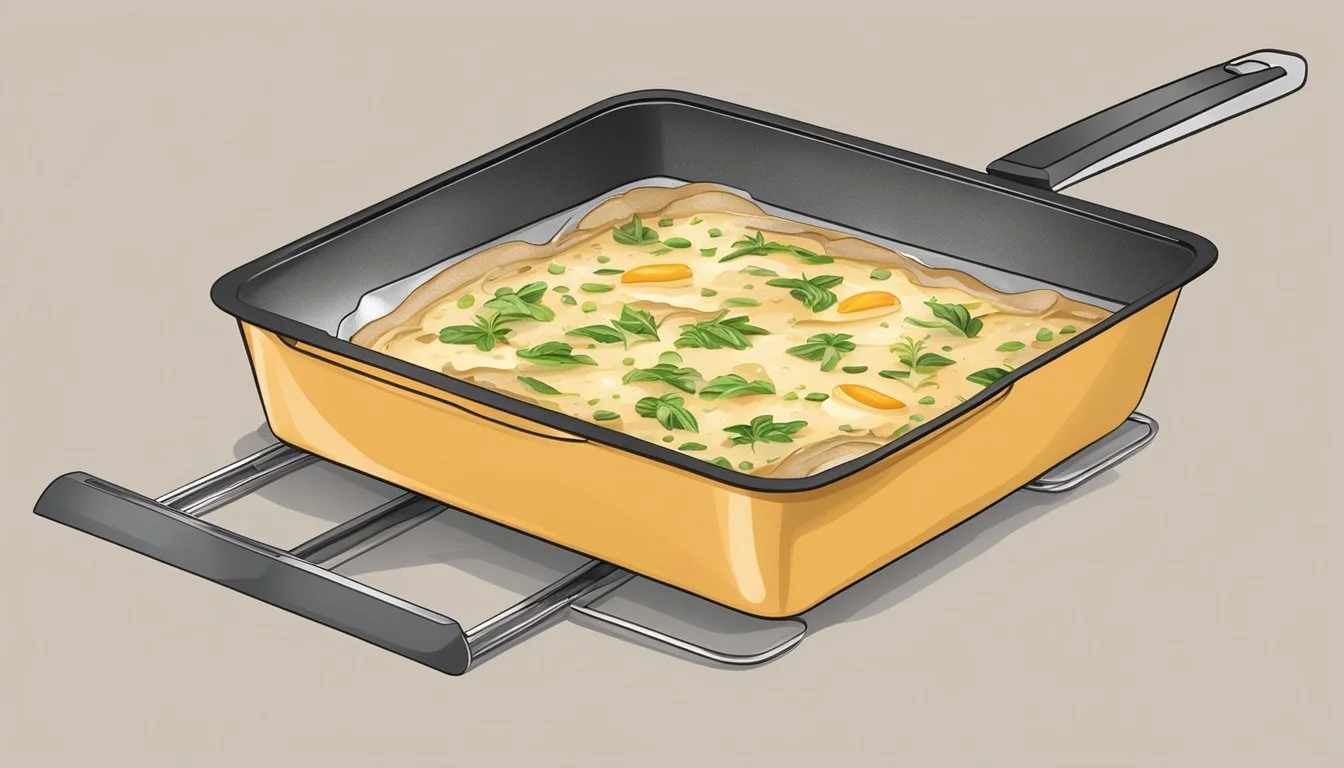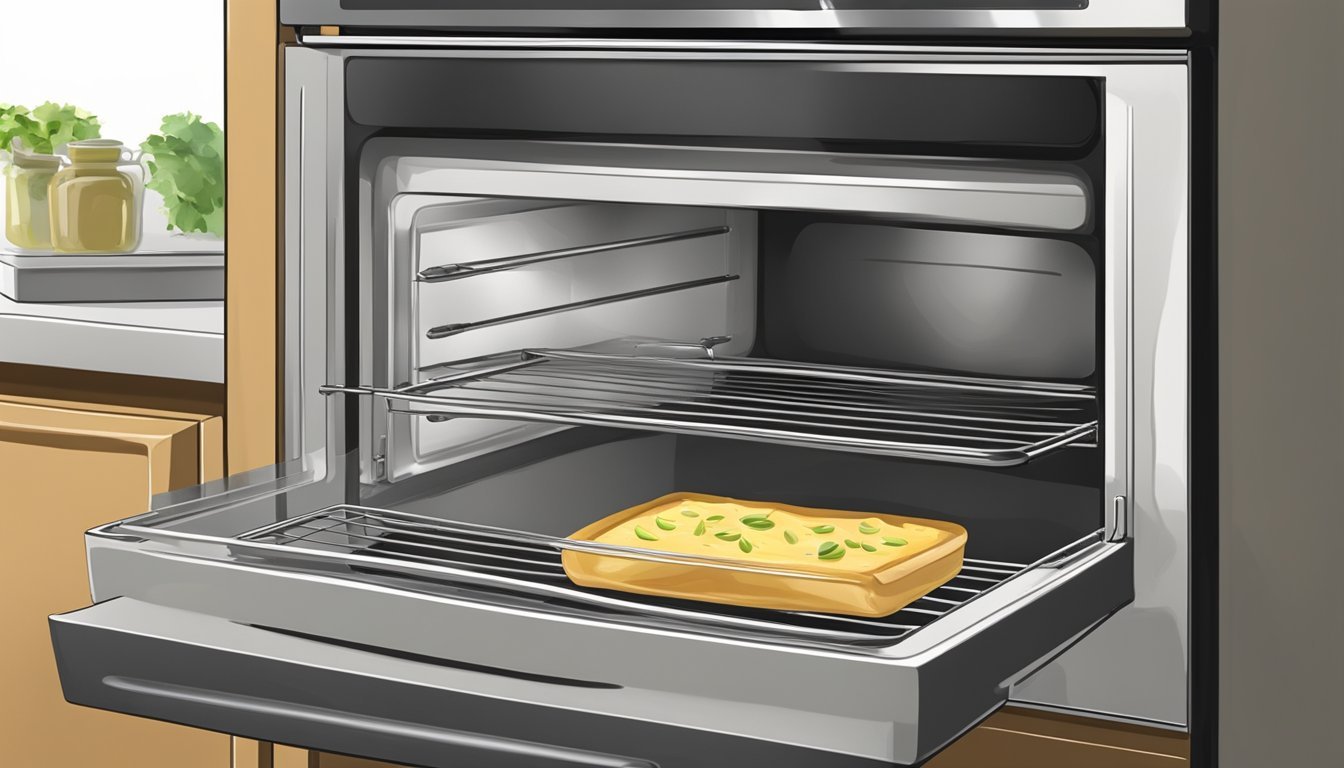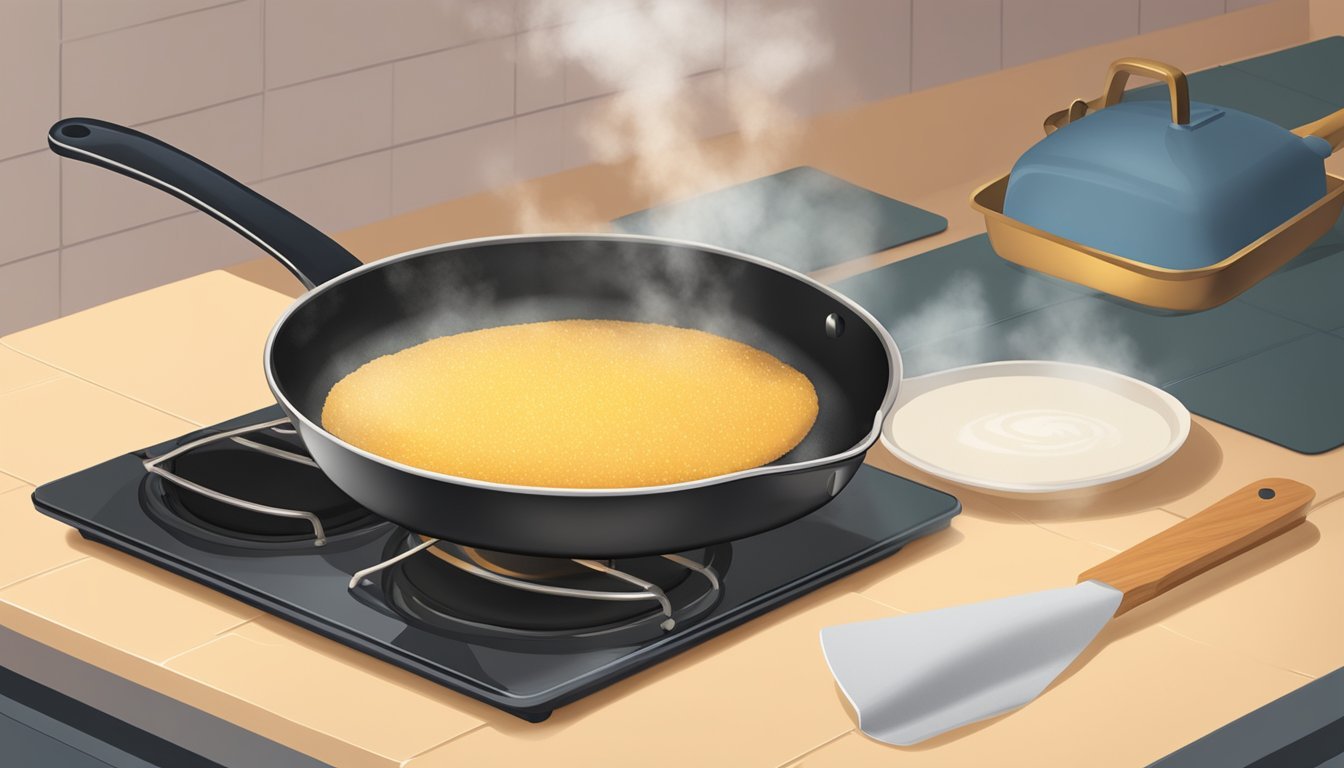How to Reheat Farinata
Best Methods and Tips
Farinata, the delicious Italian chickpea pancake, is a favorite snack known for its crispy edges and soft center. When reheating farinata, many worry about losing that perfect texture. The best way to reheat farinata and keep it crispy is by using the oven or a skillet.
The oven method involves placing the farinata on a baking tray and lightly brushing it with olive oil if it's dry. This helps restore both moisture and crispness. Alternatively, reheating farinata in a skillet over medium heat can also bring back its crunchy texture.
For those who have frozen farinata, it can be reheated directly in the oven without thawing. Ensuring farinata retains its original savory flavor and texture can make it just as enjoyable as when it was first made.
Understanding Farinata
Farinata, a traditional Ligurian dish from Genoa, Italy, is a savory chickpea flour pancake. This dish is known by various names in different regions, such as fainè in Sardinia, cecina in Tuscany, and socca in Nice.
Made from chickpea flour, farinata is naturally gluten-free and vegan. It's a rich source of protein, fiber, and potassium.
Ingredients
Chickpea flour: The base of farinata, providing a nutty flavor.
Water: Used to form a batter with the chickpea flour.
Olive oil: Adds richness and ensures a crispy texture.
Salt: Enhances flavor.
Rosemary: An optional herb that pairs well with the earthy taste of chickpea flour.
Preparation
Mixing: Combine chickpea flour, water, olive oil, and salt. Let it rest to create a smooth batter.
Resting: Allow the mixture to sit for several hours, helping the flour to fully hydrate.
Cooking: Pour into a hot, oiled pan and bake until golden brown.
Cultural Significance
Farinata has deep roots in Ligurian cuisine, often enjoyed as a street food. Its simplicity and wholesome ingredients make it a beloved dish, not only in Italy but also in various Mediterranean regions.
By understanding the basics of farinata, one can appreciate both its culinary value and cultural heritage.
Essential Ingredients and Tools
To reheat farinata effectively, specific ingredients and tools are necessary to achieve a crispy and flavorful result. This guide focuses on the essential elements and equipment needed in the kitchen.
Key Ingredients for Farinata
Chickpea flour: The main ingredient, chickpea flour forms the base of the farinata. It provides a distinctive nutty flavor and ensures a gluten-free dish.
Water: Combine with chickpea flour to create a smooth batter. Ensure the water is at room temperature for optimal blending.
Salt: Enhances the natural flavors in the farinata. Use fine sea salt for the best results.
Extra virgin olive oil: Adds richness and helps achieve a crispy texture during reheating. Ensure it’s of high quality.
Rosemary: Optional but provides a fragrant aroma and additional flavor. Fresh rosemary is recommended.
Black pepper: Adds a subtle heat. Freshly ground black pepper works best.
Required Baking Tools
Skillet or pan: A non-stick skillet is crucial for reheating. It ensures that the farinata doesn't stick and helps in attaining a crispy edge.
Cast-iron skillet or copper pan: Preferred choices for even heat distribution. They retain heat well, aiding in the reheating process.
Oven: Necessary for the final baking stage. Helps achieve the desired golden crust.
Baking pan: A medium-sized baking pan, preferably greased, is needed if a skillet is unavailable.
Spoon or whisk: Essential for stirring the batter and ensuring all ingredients are well combined.
Oven mitts: Important for handling hot pans and skillets safely during the reheating process.
Farinata Recipe Overview
Farinata, an Italian chickpea flatbread, combines simple ingredients to create a dish that's both nutritious and flavorful. This easy recipe is vegan and gluten-free, resulting in a crispy, golden exterior with a tender interior.
Step-by-Step Farinata Preparation
To make farinata, start by preparing the batter. Mix chickpea flour, salt, and warm water in a large bowl until you get a smooth, pale yellow mixture. Cover the bowl and let it sit for at least 30 minutes. Some recipes recommend letting the batter rest for up to 5 hours for best results.
After the resting period, preheat your oven to 475 degrees Fahrenheit. Stir the batter and skim off any foam that has formed. Add olive oil to the mixture and mix thoroughly. Pour the batter into a hot, oiled cast-iron skillet and bake for 15-20 minutes.
For a crispier texture, you can finish cooking under the broiler for an additional 3-4 minutes until the top is golden brown. Sprinkle with flaky sea salt and cut into squares or wedges before serving.
Texture and Flavor Profile
Farinata boasts a unique texture; the exterior is crisp from the high-temperature baking, while the interior remains moist and tender. The use of olive oil helps achieve this balance, providing a slightly nutty flavor that complements the nuttiness of the chickpea flour.
Herbs like rosemary can be added to the batter for additional aromatic notes. Each bite offers a savory flavor, making farinata an excellent protein-rich option that's both vegan and gluten-free. It serves well on its own or as a base for various toppings, similar to focaccia.
Proper Reheating Techniques
Reheating farinata while maintaining its characteristic crispy edges and savory flavor is key. This section discusses the best methods to achieve this using both traditional and alternative techniques.
Oven Reheating Method
Reheating farinata in the oven is highly recommended to preserve its texture. Preheat the oven to 475°F and place a cast-iron skillet inside to heat up. A heated skillet ensures the farinata crisps up properly.
Once the oven and skillet are hot, place the farinata in the skillet and bake for 5-8 minutes. This method helps recrisp the edges and keeps the farinata warm without drying it out. Check for a golden color and firm texture before removing from the oven. If desired, broil for an additional 1-2 minutes for extra crispiness.
Alternative Reheating Methods
For those without an oven, there are other effective methods. Air fryer reheating is quick and efficient. Set the air fryer to 380°F and cook the farinata for 3-5 minutes. This method maintains a crispy texture.
A toaster oven is another good alternative. Preheat to 375°F and reheat the farinata for 5-7 minutes until warm and crispy. To maintain moisture, avoid overcooking.
While stovetop methods are less ideal, a skillet can be used. Heat a non-stick skillet over medium heat and reheat the farinata for 3-4 minutes on each side. Add a few drops of water and cover to steam for 1 minute, which helps avoid drying out.
Serving Suggestions and Pairings
Farinata is versatile and pairs well with a variety of sides and creative toppings. Serving it with refreshing salads, savory spreads, or roasted vegetables can elevate your meal.
Appetizer and Side Dish Ideas
White Bean and Cucumber Salad
A refreshing combination that adds crunch and lightness. Mix white beans with diced cucumber, red onion, and a vinaigrette made from olive oil and lemon juice.
Eggplant Caponata
A flavorful Sicilian dish featuring eggplant, tomato, olives, and capers. It provides a hearty and tangy profile that complements the farinata.
Simple Green Salad
A mix of greens like arugula, spinach, or mixed lettuce, dressed with olive oil and balsamic vinegar. Add cherry tomatoes, red onions, and cucumber slices for extra freshness.
Tomato Soup
Provides a warm and comforting side, perfect for dipping pieces of farinata. Consider a rich, homemade tomato soup with basil and a touch of cream.
Pan-Seared Mushrooms
A savory option that enhances the earthy flavors of farinata. Sauté mushrooms with garlic, thyme, and a bit of white wine for a flavorful addition.
Creative Toppings and Variations
Traditional Basil Pesto
Drizzle over the farinata for a classic, aromatic touch. Made from basil, pine nuts, Parmesan cheese, garlic, and olive oil, this adds a delightful herbal note.
Sun-Dried Tomato Pesto
Offers a sweet and tangy twist. Blending sun-dried tomatoes with garlic, Parmesan, and almonds provides a unique flavor profile.
Arugula Pesto
For a peppery kick, use arugula instead of basil. Combine with walnuts or pine nuts, garlic, and Parmesan for a robust topping.
Roasted Vegetables
Top the farinata with roasted zucchini, bell peppers, and onions. This adds color and a depth of flavor through caramelization.
Whipped Goat Cheese with Roasted Beets
Spread whipped goat cheese over the farinata and top with roasted beets. This combination brings a creamy texture and sweet earthiness.
Olive Tapenade
A mix of finely chopped olives, capers, and anchovies. Spread this Mediterranean topping to introduce a briny, savory element.
Storage and Preservation
Proper storage is crucial to maintaining the quality and taste of farinata. Both refrigeration and freezing are viable methods, but they require specific steps to ensure that your farinata remains appetizing when reheated.
Storing Cooked Farinata
Cooked farinata should be stored in an airtight container to prevent exposure to air and moisture.
Room Temperature: If you plan to consume the farinata within a day or two, it can be kept at room temperature. Ensure it’s covered well to avoid sogginess.
Refrigeration: For longer storage, place the farinata in the refrigerator, where it can stay fresh for up to 4 days. Before storing, let it cool completely. This helps in maintaining its texture. Reheat in an oven at 400°F (200°C) for about 5 minutes to restore its crispiness before serving.
Freezing and Thawing Practices
Farinata can also be frozen for extended storage.
Freezer: To freeze farinata, place individual portions in a freezer-safe container or ziplock bags. Make sure to remove as much air as possible before sealing to prevent freezer burn. It can be stored in the freezer for up to 3 months.
Thawing and Reheating: There’s no need to thaw farinata before reheating. Preheat your oven to 400°F (200°C) and place the frozen farinata directly in the oven. Heat for 10-15 minutes until it’s hot and crispy. This method ensures the farinata retains its desirable texture and flavor.
Cultural Significance and History
Farinata, a traditional Ligurian dish, has a rich history tied to the Mediterranean region. Its variants have spread to parts of Italy and even across national borders, reflecting its cultural importance and culinary evolution.
Farinata in Italian Cuisine
Farinata traces its roots to Liguria, specifically Genoa. According to legend, it was created after the Battle of Meloria in 1284 when Genoa defeated Pisa. A storm spilled chickpea flour and olive oil, which then baked on the sun-soaked decks of ships, giving rise to this flatbread.
In Liguria, farinata is enjoyed in casual eateries known as sciamadda. These places, characterized by wood-fired ovens, offer a variety of local baked goods. Farinata serves as a representation of the region's resourcefulness and culinary heritage.
Worldwide Variations of Chickpea Flatbread
Chickpea flatbread has various names and forms beyond Liguria. In Tuscany, it is known as cecina, offering a similar preparation but with regional flair. The French Riviera, particularly in Nice, enjoys a version called socca, which is slightly thinner but equally beloved.
These variations highlight the adaptability of chickpea flour-based dishes in Mediterranean cuisine. Each region has added its own touch, from the ovens used to the specific condiments, showcasing the dish's versatility and enduring appeal across different cultures.
Health Benefits and Considerations
Farinata offers several nutritional benefits due to its core ingredient, chickpea flour, which is rich in proteins and various essential nutrients. There are also important considerations regarding dietary restrictions and allergens.
Nutritional Profile
Farinata is made from chickpea flour, making it naturally gluten-free and suitable for a vegan diet. Chickpeas are an excellent source of protein, providing essential amino acids that support muscle repair and overall health.
Fiber is another key component, aiding digestion and promoting a healthy gut. A 100-gram serving often contains 5-7 grams of fiber.
Chickpeas are also rich in minerals like potassium, which helps regulate blood pressure, and folate, important for cell division and DNA synthesis.
This nutrient profile makes farinata a nutritious option for those following a plant-based or gluten-free diet.
Allergen Information
While farinata itself is gluten-free and dairy-free, cross-contamination can occur if prepared in facilities that also process gluten or dairy products.
Individuals with severe gluten intolerance or celiac disease should ensure that their chickpea flour is certified gluten-free.
Additionally, chickpea allergies, though rare, do exist and can cause adverse reactions.
It's always advisable to check ingredient labels and consult with a healthcare professional if there are any concerns about allergens. This precaution is crucial for those with multiple food sensitivities or severe allergies.
Farinata FAQs Synthesis
Farinata is a versatile dish with unique characteristics. This section addresses common questions that arise about this Ligurian chickpea pancake.
Common Questions About Farinata
What is Farinata?
Farinata, also known as socca, is a chickpea pancake from Italy, often enjoyed as a flatbread or pizza crust alternative. It is made from a simple batter of chickpea flour, water, olive oil, and salt. This dish is both gluten-free and vegan, catering to various dietary preferences.
How do you reheat Farinata?
To reheat farinata, use a cast-iron skillet for best results. Preheat the oven to 475 degrees Fahrenheit and warm the skillet inside. Once hot, place the farinata in the skillet and bake for 10-15 minutes until edges are crispy and the center is warmed through. This method helps maintain its texture and flavor.
Can Farinata be used as a pizza crust?
Yes, farinata can serve as an alternative pizza crust. After baking the farinata, add your desired toppings and place it back in the oven until the toppings are cooked to your liking. This provides a flavorful and nutritious pizza base that is naturally gluten-free.
What are the key nutritional benefits of Farinata?
Farinata is rich in protein, fiber, and iron due to the chickpea flour. It’s a nutritious option for those looking for a high-protein, gluten-free, and vegan alternative to traditional bread recipes and pancake-based dishes.










